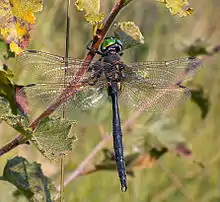Northern emerald
The northern emerald (Somatochlora arctica) is a middle-sized species of dragonfly first described by Johan Wilhelm Zetterstedt in 1840. The male can be recognised by its pincer-like appendages and its narrow-waisted body. The female has distinctive orange-yellow spots on (only) the third segment of the abdomen.
| Northern emerald | |
|---|---|
 | |
| Male | |
| Scientific classification | |
| Domain: | Eukaryota |
| Kingdom: | Animalia |
| Phylum: | Arthropoda |
| Class: | Insecta |
| Order: | Odonata |
| Infraorder: | Anisoptera |
| Family: | Corduliidae |
| Genus: | Somatochlora |
| Species: | S. arctica |
| Binomial name | |
| Somatochlora arctica (Zetterstedt, 1840) | |
| Synonyms[1] | |
This species lives in bogs and lays its eggs in very small water-filled depressions. It hunts between trees and avoids open spaces.
In Great Britain, it is only present in north-western Scotland and is confined to the south-western part of Ireland.[2] It is present in all of northern Eurasia. In Western Europe, it is present in alpine areas and wherever a suitable habitat can be found. It is found in the Rila mountains of Bulgaria.
References
- Paulson, D.; Schorr, M.; Abbott, J.; Bota-Sierra, C.; Deliry, C.; Dijkstra, K.-D.; Lozano, F. (2023). "World Odonata List". OdonataCentral, University of Alabama. Retrieved 14 Mar 2023.
- "Somatochlora arctica - Northern Emerald". British Dragonfly Society. 2011-05-28.
This article is issued from Wikipedia. The text is licensed under Creative Commons - Attribution - Sharealike. Additional terms may apply for the media files.